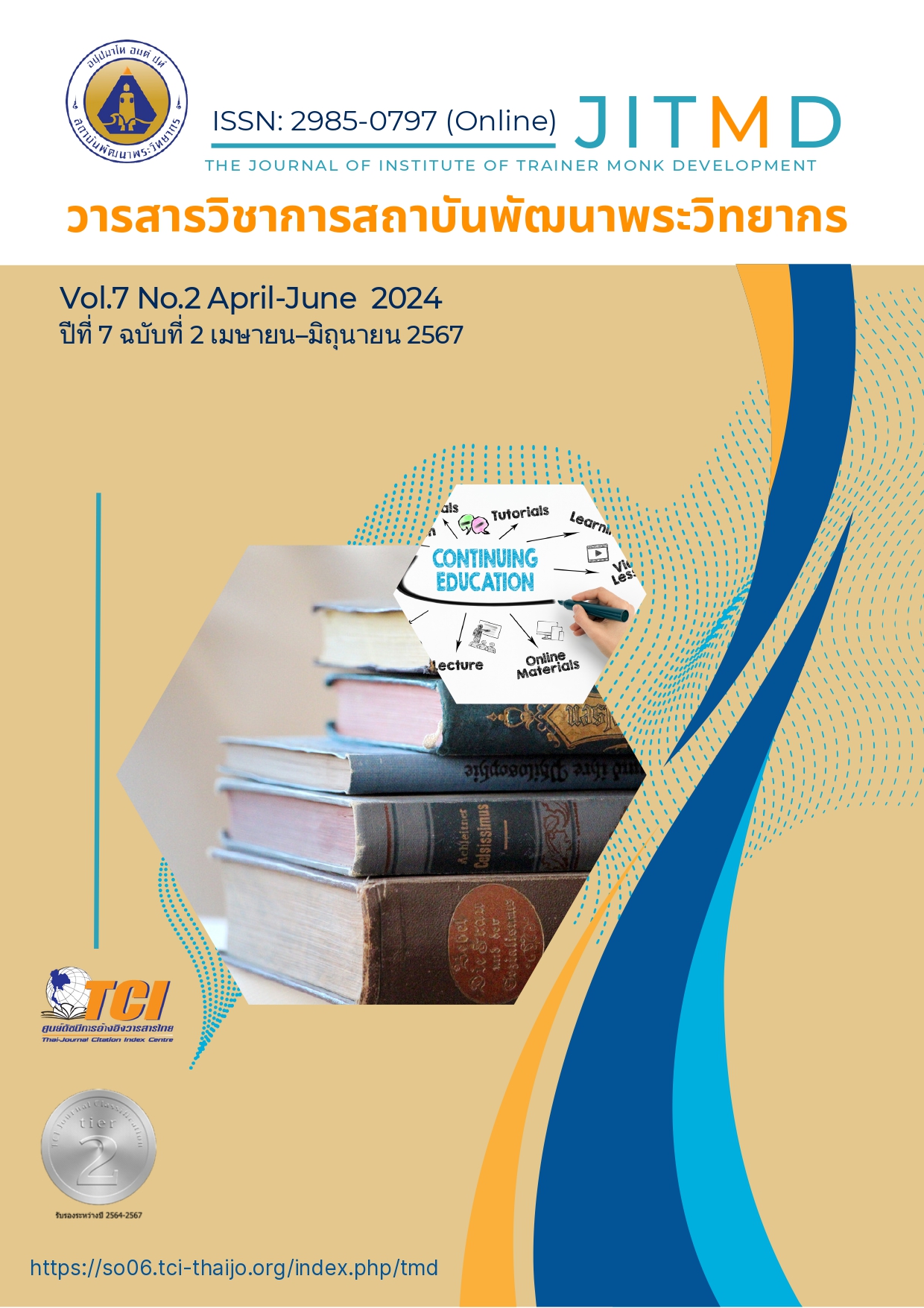The Motivation of Volunteer Monks in Aranyaprathet District Sakaeo Province
Main Article Content
Abstract
The purposes of this study are to: 1) Study the characteristics of the motivational components of being a volunteer monk in the Aranyaprathet District, Sakaeo Province; 2) study ways to encourage volunteer-minded monks in the Aranyaprathet District, Sakaeo Province; and 3) develop a model for providing motivation for being a volunteer monk. This research is qualitative research with 12 of volunteer monks in Sakaeo province who stayed the Buddhist Lent and whose works were obvious in the Aranyaprathet District, we had the ability to sample the population by In-depth interview questions and content analysis. It was founded that : 1) there are two incentive factors: internal factors: spirituality, providers, demanders, sociality, unpaid workers and free help to others; External factors: the framework and policies of clergy; Good social conditions and role models; 2) Work and motivation: knowledge development; Ideological adaptation; Adapting to different situations by encouraging participation; Buddhist principles supporting the characteristics of volunteerism, including the Four Paths of Accomplishment, four holy abiding and four objects of sympathy. 3) Systematically form a volunteer work model, that is, set goals, have a positive attitude, act immediately, establish a network, and continue to work.
Article Details

This work is licensed under a Creative Commons Attribution-NonCommercial-NoDerivatives 4.0 International License.
บทความที่ได้รับการตีพิมพ์เป็นลิขสิทธิ์ของวารสารวิชาการสถาบันพัฒนาพระวิทยากร
ข้อความที่ปรากฎอยู่ในบทความที่ได้รับการตีพิมพ์ในวารสาร ถือเป็นความรับผิดชอบของผู้เขียนบทความ และข้อคิดเห็นนั้นไม่ถือว่าเป็นทัศนะและความรับผิดชอบของกองบรรณาธิการวารสารวิชาการสถาบันพัฒนาพระวิทยากร
References
กัญจิรา วิจิตรวัชรารักษ์ และคณะ. (2564). การส่งเสริมเครือข่ายจิตอาสาของพระสงฆ์ เขตภาคกลางตอนล่างในประเทศไทย. วารสารสังคมศาษสตรและมานุษยวิทยาเชิงพุทธ, 6(7): 351-365.
กัลป์ยกร ลาภเดโช และสมบูรณ์ สุขสำราญ. (2565) บทบาทพระสงฆ์กับการพัฒนาสังคมไทย. วารสารมณีเชษฐาราม วัดจอมมณี, 5(1): 2-14.
คณะกรรมการฝ่ายสาธารณสงเคราะห์ของมหาเถรสมาคม. (2562). คู่มือการปฏิบัติงานฝ่ายสาธารณสงเคราะห์ของมหาเถรสมาคม(2562). สืบค้นข้อมูลเมื่อ 25 ตุลาคม 2565 จากhttps://issuu.com/penkiatsitthisit/docs/7fdcd55cbe71d2
ชมัยพร พึ่งม้าย. (2562). อิทธิพลของการได้รับการอบรมเลี้ยงดู ทัศนคติ การรับข่าวสาร และแรงจูงใจ ที่มีต่อพฤติกรรมจิตสาธารณะของผู้ที่อยู่ในวัยทำงานในกรุงเทพมหานคร.วิทยานิพนธ์วิทยาศาสตร์มหาบัณฑิต (สถิติประยุกต์). สถาบันบัณฑิตพัฒนาบริหารศาสตร์ คณะสถิติประยุกต์.
พระครูประโชติพัชรพงศ์ (นัฐพงษ์ วิสุทฺโธ) และคณะ. (2564). แนวทางการเสริมสร้างบทบาทพระคิลานุปัฏฐาก ในการเสริมสร้างสุขภาวะของพระสงฆ์ไทย. Journal of Modern Learning Development, 6(5): 119-126.
พระจเร ธมฺมจิตโต (จันทร์บาง) และมานพ นักการเรียน. (2564). การส่งเสริมจิตอาสาตามหลักของพระโพธิสัตว์.วารสารมหาจุฬาวิชาการ, 8(1): 72-83.
พระมาหาอุเทน โพธิ์ศรีประเสริฐ และคณะ. (2564). องค์ประกอบของการเสริมสร้างแรงจูงใจในการปฎิบัติงานของครูโรงเรียนการกุศลของวัดในพระพุทธศาสนา. วารสารวิทยาลัยสงฆ์นครลำปาง, 10(1): 204-215.
พระอธิการณัฐพล ปญฺญาวุฑฺโต (สมยา) และคณะ. (2564). จิตอาสาและรูปแบบการัฒนาของพระคิลานุปัฏฐากพระสงฆ์อำเภอห้างฉัตร จังหวัดลำปาง. วารสารวิทยาลัยสงฆ์นครลำปาง, 10(1): 33-45.
พินิจ ลาภธนานนท์. (2526). อดีต ปัจจุบัน และอนาคตงานสาธารณสงเคราะห์วิธีพุทธของคณะสงฆ์ไทย. นนทบุรี: นิติธรรมการพิมพ์.
พิไลวรรณ บุญล้น และคณะ. (2564). แรงจูงใจการทำงานจิตอาสาตามหลักพุทธจิตวิทยาของบุคคลหลากหลายอาชีพในสังคมไทย. วิทยานิพนธ์ปริญญามหาบันฑิต. คณะมนุษยศาสตร์ บัณฑิตวิทยาลัย: มหาวิทยาลัยจุฬาลงกรณราชวิทยาลัย.
เพริศพรรณ แดนศิลป์ และคณะ. (2563). การเปลี่ยนแปลงมิติภายในของพระสงฆ์กลุ่มอาสาคิลานธรรมภายหลังเข้าร่วมหลักสูตรการปรึกษาเชิงจิตวิทยาแนวพุทธและในระยะติดตามผลการปฏิบัติงานต่อผู้ป่วยระยะสุดท้าย. วารสารศึกษาศาสตร์ มหาวิทยาลัยขอนแก่น, 43(1): 15-29.
สำนักข่าวไทยโพสต์. (2565). วธ.ร่วมตั้งโรงทานสู้พิษโควิดตามพระบัญชาสมเด็จพระสังฆราช. สืบค้นข้อมูลเมื่อ 20 ตุลาคม 2565 จาก https://www.thaipost.net/main/detail/61500


